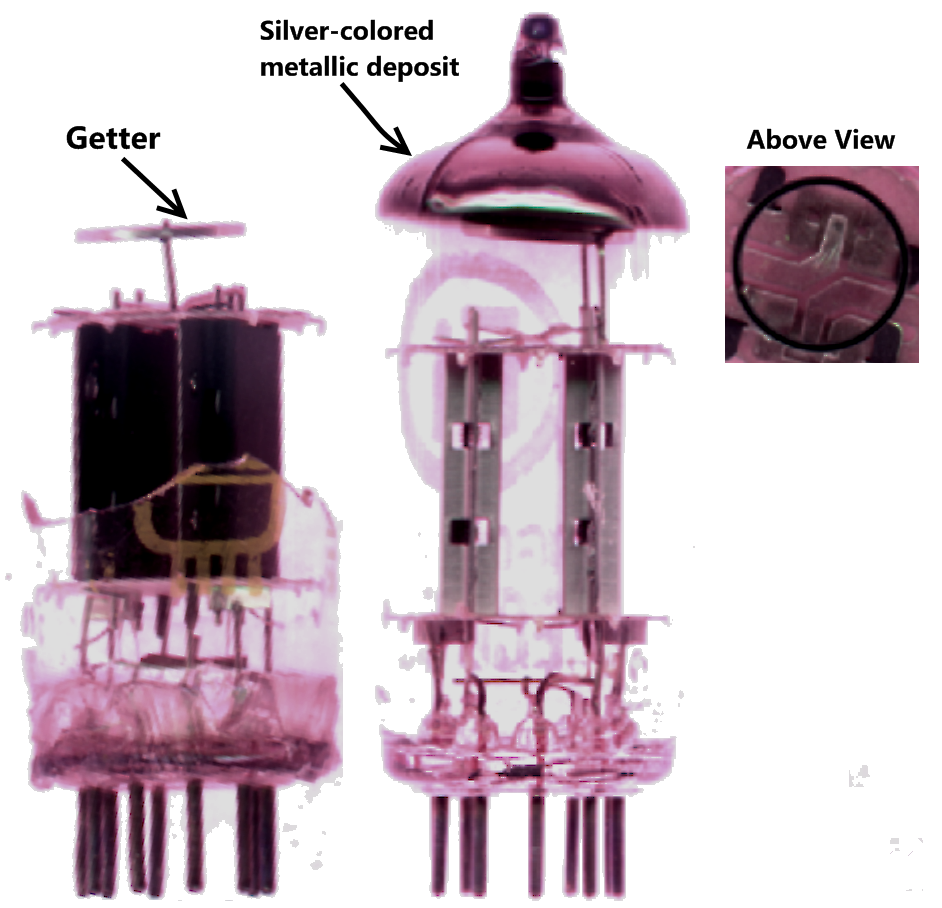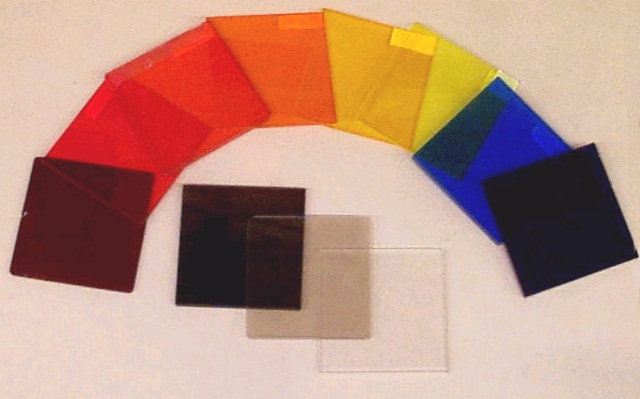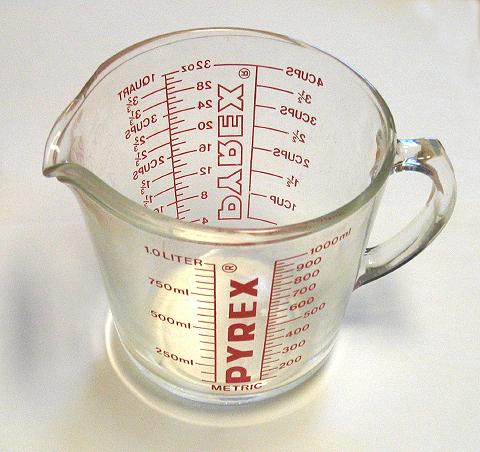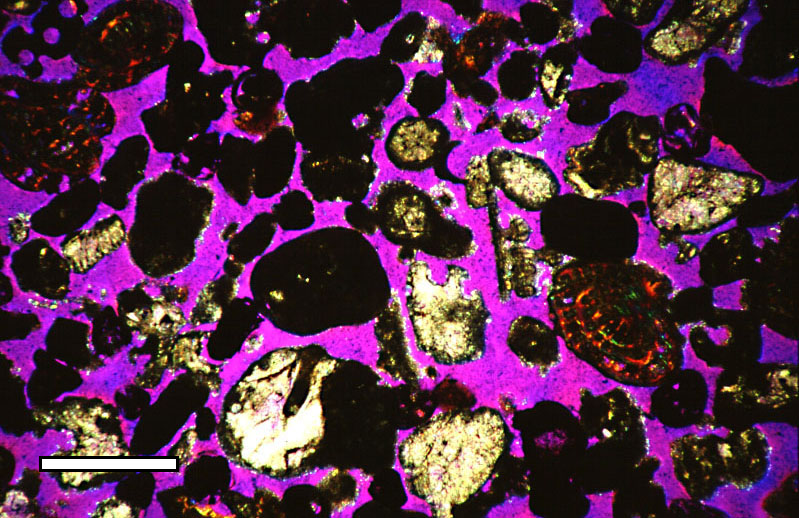|
Vycor
Vycor is the brand name of Corning's high-silica, high-temperature glass. It provides very high thermal shock resistance. Vycor is approximately 96% silica and 4% boron trioxide, but unlike pure fused silica, it can be readily manufactured in a variety of shapes. Vycor can be subject to prolonged usage at 900 °C. Vycor products are made by a multi-step process. First, a relatively soft alkali-borosilicate glass is melted and formed by typical glassworking techniques into the desired shape. This is heat-treated, which causes the material to separate into two intermingled "phases" with distinct chemical compositions. One phase is rich in alkali and boric oxide and can be easily dissolved in acid. The other phase is mostly silica, which is insoluble. The glass object is then soaked in a hot acid solution, which leaches away the soluble glass phase, leaving an object which is mostly silica. At this stage, the glass is porous. Finally, the object is heated to more than 1200 °C, ... [...More Info...] [...Related Items...] OR: [Wikipedia] [Google] [Baidu] |
Germicidal Lamp
A germicidal lamp (also known as disinfection lamp or sterilizer lamp) is an electric light that produces ultraviolet C (UVC) light. This short-wave ultraviolet light disrupts DNA base pairing, causing formation of pyrimidine dimers, and leads to the inactivation of bacteria, viruses, and protozoans. It can also be used to produce ozone for water disinfection. They are used in ultraviolet germicidal irradiation (UVGI). There are four common types available: * Low-pressure mercury lamps * High-pressure mercury lamps * Excimer lamps * LEDs Low-pressure mercury lamps Low-pressure mercury lamps are very similar to a fluorescent lamp, with a wavelength of 253.7 nm (1182.5 THz). The most common form of germicidal lamp looks similar to an ordinary fluorescent lamp but the tube contains no fluorescent phosphor. In addition, rather than being made of ordinary borosilicate glass, the tube is made of fused quartz or vycor 7913 glass. These two changes combine to allow th ... [...More Info...] [...Related Items...] OR: [Wikipedia] [Google] [Baidu] |
Ultraviolet
Ultraviolet radiation, also known as simply UV, is electromagnetic radiation of wavelengths of 10–400 nanometers, shorter than that of visible light, but longer than X-rays. UV radiation is present in sunlight and constitutes about 10% of the total electromagnetic radiation output from the Sun. It is also produced by electric arcs, Cherenkov radiation, and specialized lights, such as mercury-vapor lamps, tanning lamps, and black lights. The photons of ultraviolet have greater energy than those of visible light, from about 3.1 to 12 electron volts, around the minimum energy required to ionize atoms. Although long-wavelength ultraviolet is not considered an ionizing radiation because its photons lack sufficient energy, it can induce chemical reactions and cause many substances to glow or fluoresce. Many practical applications, including chemical and biological effects, are derived from the way that UV radiation can interact with organic molecules. The ... [...More Info...] [...Related Items...] OR: [Wikipedia] [Google] [Baidu] |
Corning Incorporated
Corning Incorporated is an American multinational technology company specializing in glass, ceramics, and related materials and technologies including advanced optics, primarily for industrial and scientific applications. The company was named Corning Glass Works until 1989. Corning divested its consumer product lines (including CorningWare and Visions Pyroceram-based cookware, Corelle Vitrelle tableware, and Pyrex glass bakeware) in 1998 by selling the Corning Consumer Products Company subsidiary (later Corelle Brands) to Borden. , Corning had five major business sectors: display technologies, environmental technologies, life sciences, optical communications, and specialty materials. Corning is involved in two joint ventures: Dow Corning and Pittsburgh Corning. The company completed the corporate spin-offs of Quest Diagnostics and Covance (now Fortrea) in January 1997. Corning is one of the main suppliers to Apple Inc. Since working with Steve Jobs in 2007, to develop ... [...More Info...] [...Related Items...] OR: [Wikipedia] [Google] [Baidu] |
Getter
A getter is a deposit of reactive material that is placed inside a vacuum system to complete and maintain the vacuum. When gas molecules strike the getter material, they combine with it chemically or by adsorption. Thus the getter removes small amounts of gas from the evacuated space. The getter is usually a coating applied to a surface within the evacuated chamber. A vacuum is initially created by connecting a container to a vacuum pump. After achieving a sufficient vacuum, the container can be sealed, or the vacuum pump can be left running. Getters are especially important in sealed systems, such as vacuum tubes, including cathode-ray tubes (CRTs), vacuum insulating glass (or vacuum glass) and vacuum insulated panels, which must maintain a vacuum for a long time. This is because the inner surfaces of the container release adsorbed gases for a long time after the vacuum is established. The getter continually removes residues of a reactive gas, such as oxygen, as long as it i ... [...More Info...] [...Related Items...] OR: [Wikipedia] [Google] [Baidu] |
Confined Liquid
In condensed matter physics, a confined liquid is a liquid that is subject to geometric constraints on a nanoscopic scale so that most molecules are close enough to an interface to sense some difference from standard bulk liquid conditions. Typical examples are liquids in porous media, gels, or bound in solvation shells. Confinement regularly prevents crystallization, which enables liquids to be supercooled below their homogeneous nucleation temperature even if this is impossible in the bulk state. This holds in particular for water Water is an inorganic compound with the chemical formula . It is a transparent, tasteless, odorless, and Color of water, nearly colorless chemical substance. It is the main constituent of Earth's hydrosphere and the fluids of all known liv ..., which is by far the most studied confined liquid. Liquids under sub-millimeter confinement (e.g. in the gap between rigid walls) exhibit a nearly solid-like mechanical response and possess a surprisi ... [...More Info...] [...Related Items...] OR: [Wikipedia] [Google] [Baidu] |
Filter (optics)
An optical filter is a device that selectively transmits light of different wavelengths, usually implemented as a glass plane or plastic device in the optical path, which are either dyed in the bulk or have interference coatings. The optical properties of filters are completely described by their frequency response, which specifies how the magnitude and phase of each frequency component of an incoming signal is modified by the filter. Filters mostly belong to one of two categories. The simplest, physically, is the absorptive filter; then there are interference or dichroic filters. Many optical filters are used for optical imaging and are manufactured to be transparent; some used for light sources can be translucent. Optical filters selectively transmit light in a particular range of wavelengths, that is, colours, while absorbing the remainder. They can usually pass long wavelengths only (longpass), short wavelengths only (shortpass), or a band of wavelengths, bloc ... [...More Info...] [...Related Items...] OR: [Wikipedia] [Google] [Baidu] |
Metrology
Metrology is the scientific study of measurement. It establishes a common understanding of Unit of measurement, units, crucial in linking human activities. Modern metrology has its roots in the French Revolution's political motivation to standardise units in France when a length standard taken from a natural source was proposed. This led to the creation of the decimal-based metric system in 1795, establishing a set of standards for other types of measurements. Several other countries adopted the metric system between 1795 and 1875; to ensure conformity between the countries, the ''International Bureau of Weights and Measures, Bureau International des Poids et Mesures'' (BIPM) was established by the Metre Convention. This has evolved into the International System of Units (SI) as a result of a resolution at the 11th General Conference on Weights and Measures (CGPM) in 1960. Metrology is divided into three basic overlapping activities: * The definition of units of measurement * ... [...More Info...] [...Related Items...] OR: [Wikipedia] [Google] [Baidu] |
Pyrex
Pyrex (trademarked as ''PYREX'' and ''pyrex'') is a brand introduced by Corning Inc. in 1915, initially for a line of clear, low-thermal-expansion borosilicate glass used for laboratory glassware and kitchenware. It was later expanded in the 1930s to include kitchenware products made of soda–lime glass and other materials. Its name has become famous for making rectangular glass roasters. In 1998, the kitchenware division of Corning Inc. responsible for the development of Pyrex spun off from its parent company as Corning Consumer Products Company, subsequently renamed Corelle Brands. Corning Inc. no longer manufactures or markets consumer products, only industrial ones. History Borosilicate glass was first made by German chemist and glass technologist Otto Schott, founder of Schott AG in 1893, 22 years before Corning produced the Pyrex brand. Schott AG sells the product under the name "Duran". In 1908, Eugene Sullivan, director of research at Corning Inc., Corning Glass ... [...More Info...] [...Related Items...] OR: [Wikipedia] [Google] [Baidu] |
Porosity
Porosity or void fraction is a measure of the void (i.e. "empty") spaces in a material, and is a fraction of the volume of voids over the total volume, between 0 and 1, or as a percentage between 0% and 100%. Strictly speaking, some tests measure the "accessible void", the total amount of void space accessible from the surface (cf. closed-cell foam). There are many ways to test porosity in a substance or part, such as industrial CT scanning. The term porosity is used in multiple fields including pharmaceutics, ceramics, metallurgy, materials, manufacturing, petrophysics, hydrology, earth sciences, soil mechanics, rock mechanics, and engineering. Void fraction in two-phase flow In gas-liquid two-phase flow, the void fraction is defined as the fraction of the flow-channel volume that is occupied by the gas phase or, alternatively, as the fraction of the cross-sectional area of the channel that is occupied by the gas phase. Void fraction usually varies from location to l ... [...More Info...] [...Related Items...] OR: [Wikipedia] [Google] [Baidu] |
Glass
Glass is an amorphous (non-crystalline solid, non-crystalline) solid. Because it is often transparency and translucency, transparent and chemically inert, glass has found widespread practical, technological, and decorative use in window panes, tableware, and optics. Some common objects made of glass are named after the material, e.g., a Tumbler (glass), "glass" for drinking, "glasses" for vision correction, and a "magnifying glass". Glass is most often formed by rapid cooling (quenching) of the Melting, molten form. Some glasses such as volcanic glass are naturally occurring, and obsidian has been used to make arrowheads and knives since the Stone Age. Archaeological evidence suggests glassmaking dates back to at least 3600 BC in Mesopotamia, Ancient Egypt, Egypt, or Syria. The earliest known glass objects were beads, perhaps created accidentally during metalworking or the production of faience, which is a form of pottery using lead glazes. Due to its ease of formability int ... [...More Info...] [...Related Items...] OR: [Wikipedia] [Google] [Baidu] |
Solubility
In chemistry, solubility is the ability of a chemical substance, substance, the solute, to form a solution (chemistry), solution with another substance, the solvent. Insolubility is the opposite property, the inability of the solute to form such a solution. The extent of the solubility of a substance in a specific solvent is generally measured as the concentration of the solute in a wikt:saturated#Chemistry, saturated solution, one in which no more solute can be dissolved. At this point, the two substances are said to be at the solubility equilibrium. For some solutes and solvents, there may be no such limit, in which case the two substances are said to be "miscibility, miscible in all proportions" (or just "miscible"). The solute can be a solid, a liquid, or a gas, while the solvent is usually solid or liquid. Both may be pure substances, or may themselves be solutions. Gases are always miscible in all proportions, except in very extreme situations,J. de Swaan Arons and G. A. ... [...More Info...] [...Related Items...] OR: [Wikipedia] [Google] [Baidu] |
Acid
An acid is a molecule or ion capable of either donating a proton (i.e. Hydron, hydrogen cation, H+), known as a Brønsted–Lowry acid–base theory, Brønsted–Lowry acid, or forming a covalent bond with an electron pair, known as a Lewis acid. The first category of acids are the proton donors, or Brønsted–Lowry acid–base theory, Brønsted–Lowry acids. In the special case of aqueous solutions, proton donors form the hydronium ion H3O+ and are known as Acid–base reaction#Arrhenius theory, Arrhenius acids. Johannes Nicolaus Brønsted, Brønsted and Martin Lowry, Lowry generalized the Arrhenius theory to include non-aqueous solvents. A Brønsted–Lowry or Arrhenius acid usually contains a hydrogen atom bonded to a chemical structure that is still energetically favorable after loss of H+. Aqueous Arrhenius acids have characteristic properties that provide a practical description of an acid. Acids form aqueous solutions with a sour taste, can turn blue litmus red, and ... [...More Info...] [...Related Items...] OR: [Wikipedia] [Google] [Baidu] |





